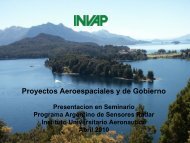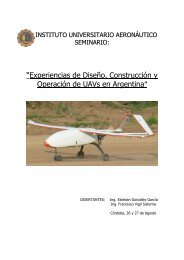Conceptual Design Requirements of a Newly Developed UAV as a ...
Conceptual Design Requirements of a Newly Developed UAV as a ...
Conceptual Design Requirements of a Newly Developed UAV as a ...
Create successful ePaper yourself
Turn your PDF publications into a flip-book with our unique Google optimized e-Paper software.
will be 1.66 m 2 at standard atmosphere. Higher atmospheric temperature and/or altitude<br />
would require slightly higher take<strong>of</strong>f speed due to reduced density. For example at 50 C o ,<br />
sea level, the take<strong>of</strong>f speed will be 26.5 m/s, only a 6% incre<strong>as</strong>e compared to standard<br />
atmosphere conditions.<br />
Structure<br />
The Present <strong>UAV</strong> h<strong>as</strong> a conventional aerodynamic configuration with pusher-type<br />
propeller See figure 4. The main fuselage h<strong>as</strong> a maximum diameter <strong>of</strong> about 350 mm to<br />
contain camer<strong>as</strong> similar to the BAI 5 <strong>as</strong> well <strong>as</strong> large fuel tank and Payload:<br />
Propeller<br />
Fuselage<br />
Camer<br />
a<br />
Figure 4: B<strong>as</strong>ic configuration <strong>of</strong> the <strong>UAV</strong>.<br />
The <strong>UAV</strong> is to be made from composites (gl<strong>as</strong>s fiber and/or Carbon fiber) and<br />
Aluminum alloy, to provide high strength to weight ratio. Skin parts and some <strong>of</strong> the<br />
skeleton supposed to be made from composite material while hard points and joints to be<br />
mainly from aluminum alloy for improved reliability. Part <strong>of</strong> the wing is supposed to be<br />
separable during storage and transportation for convenience <strong>of</strong> use and handling. For the<br />
systems contained in the fuselage they have to abide by the dimensional restrictions and<br />
maintain a re<strong>as</strong>onable static margin for stability purposes. Systems layout in the fuselage is<br />
illustrated in figure 5. Engine, landing gear and camera are supposed to have fixed<br />
locations. Fuel will be stored in multiple tanks, close to center <strong>of</strong> gravity for stability<br />
during flight and flexibility <strong>of</strong> payload <strong>as</strong> well <strong>as</strong> static margin consideration. The payload<br />
bay should contain flexible mount system for different parts and configuration <strong>of</strong><br />
communication, control and payloads. The camera is (which is a part <strong>of</strong> the payload)<br />
mounted at the bottom <strong>of</strong> the aircraft <strong>as</strong> shown in figure 5. Recovery Parachute and airbag<br />
h<strong>as</strong> to be on the center <strong>of</strong> gravity.<br />
6<br />
SSAS <strong>UAV</strong> Scientific Meeting & Exhibition, Jeddah, Saudi Arabia (June 6, 2006)<br />
Paper No. SSAS-2006-051








